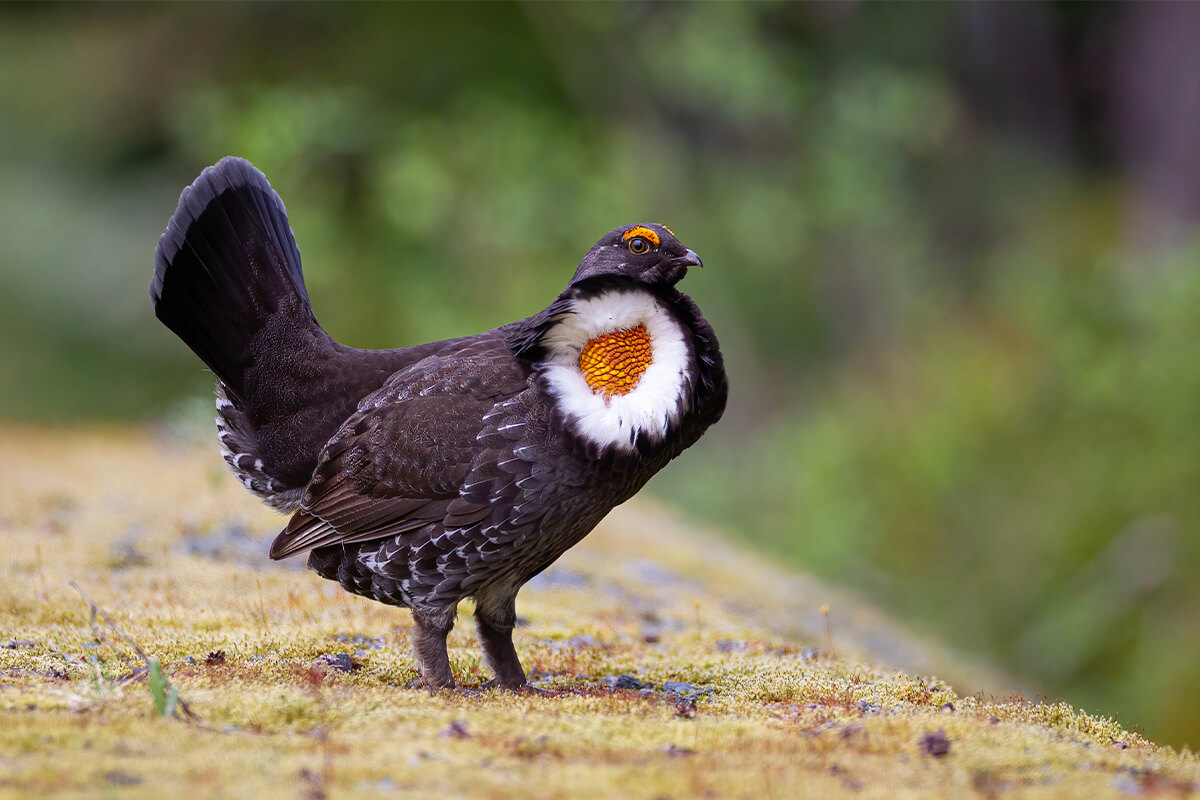
The blue grouse can be a bit confusing, as nowadays it is commonly known by three different names—and all are correct. (Photo By: Ivan_Yim/Shutterstock.com)
Also, a member of the family Phasianidae, the blue grouse was split into two different species a handful of years ago—the sooty grouse (Dendragapus Obscurus) and the dusky grouse (Dendragapus fuliginosus). Both species are found in the northwest portion of North America and were first identified and recorded by Lewis and Clark on their Voyage of Discovery.
Blue Grouse Range
The sooty grouse is the species that was formerly known as the “blue grouse” before it was split into two separate species. It is the farthest western species, with its population limited to only a few states and one Canadian province on the West Coast. Most of the birds in the United States are found along the coastal regions of Washington, Oregon and northwest California. Their range also includes most of the eastern edge of California and parts of Alaska. Its Canadian range includes the entire coast of British Columbia.

The dusky grouse, on the other hand, is a bird of the Rocky Mountains, though its range is also somewhat limited. While this bird inhabits many of the same states and provinces as the sooty grouse, their ranges do not overlap, although they are quite close in some areas. In the United States, dusky grouse are found in parts of far eastern Washington, western Montana, the northern half of Idaho, most of Wyoming, much of Colorado and Utah, and the very north central part of New Mexico. A few small pockets of them can also be found in Nevada. In Canada, they inhabit a wide swath of central British Columbia, extending on up into the Yukon and Northwest Territories.

DON'T MISS: Bird Hunting State Spotlights
Blue Grouse Biology & Habitat
The sooty grouse is a large bird, ranging in length from 15 to 20 inches at adulthood. The male is a gray to sootish-gray color, with a red to yellowish comb over its eyes. The yellow neck sack is surrounded by white feathers. Females are a plainer, spotted brown color with a dark tail.
The dusky grouse is similar in size and somewhat similar in appearance. Males are a steely blue-gray with purplish air sacs in the neck, also surrounded by white feathers and red eye combs.
million.

Concerning habitat types, the dusky grouse lives in mountainous forests made up of lodgepole and ponderosa pines, aspen, and fir. The birds survive on a simple diet of plants and insects. The sooty grouse, on the other hand, is found among brushy areas in coastal rainforests, burned areas, mountain forests and subalpine forest clearings. During warmer months they feeds on seeds, berries, and insects, turning to conifer needles to survive the colder winter months.
Females of both species build ground nests for laying their eggs and hatching their chicks. After breeding, sooty grouse females lay five to 10 eggs (sometimes up to a dozen), which are incubated by the female only for 25 to 28 days. Dusky grouse females lay a similar number of eggs and incubate them the same amount of time. The young are also able to follow the female away from the next soon after hatching.
Based on estimates from the North American Breeding Bird Survey, dusky grouse populations have been stable since 1966, with an estimated population of about 200,000 birds. While the sooty grouse population experienced a loss of over 50 percent from 1968 to 2015, their numbers are still substantially higher than the dusky with a global breeding population of about 2 million.
Hunting Blue Grouse
Both sooty grouse and dusky grouse can be hunted along with ruffed grouse and spruce grouse during the regular fall grouse hunting season in Washington. Hunting of both species is also permitted in Oregon, and also in California from mid-September to mid-October. Colorado, Idaho, Utah, and Nevada all have seasons for hunting dusky grouse.
While dusky and sooty grouse can be hunted by many of the same means as spruce grouse and other forest grouse, many people choose to hunt them without dogs because of their tendency to hang out in trees or fly into trees when pursued. Hunters with pointing dogs, however, do have some success with the birds in some parts of their range.

Check Out Our Other Grouse Profiles!
One of the stranger aspects of hunting the sooty grouse is a special spring season for the bird in Alaska. During this season, held during the “Spring Hoot,” hunters pursue these birds by walking likely areas and listening for the male’s breeding “hoot.” During that time of year, males tend to hoot from sunrise to sundown, so those who cover lots of ground are liable to find a bird or two.
As with all species of game birds, always check the regulations in the area you intend to hunt before heading afield. This is particularly true with sooty and dusky grouse since regulations vary widely from state to state.
"bird" - Google News
May 29, 2022 at 07:55AM
https://ift.tt/uihcJx7
Blue Grouse: Game Bird Profile - Gun Dog - Gun Dog Magazine
"bird" - Google News
https://ift.tt/8op3Eb1
https://ift.tt/phcgrUk
Bagikan Berita Ini














0 Response to "Blue Grouse: Game Bird Profile - Gun Dog - Gun Dog Magazine"
Post a Comment